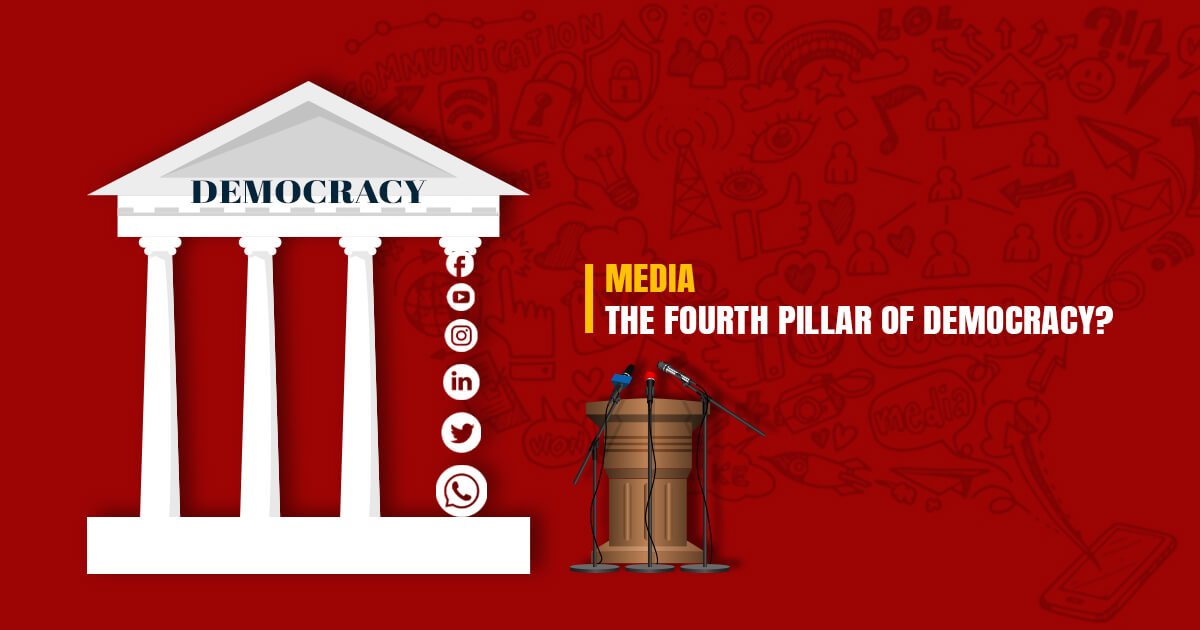Media has long been considered the fourth pillar of democracy, but what happens when this pillar becomes unreliable? A new pillar has emerged to support it: social media. Today, elections are not just battles between political parties but also wars of fake news vs. fact-checking, propaganda vs. neutral news, and big-budget campaigns vs. smart campaigns. This shift in power dynamics is significant. Why is social media becoming so crucial during these times?
The Rise of Social Media:
- Massive User Base: As of January 2024, India has an estimated 462 million active social media users, representing over 32% of the total population. This vast reach allows political parties to connect with a broader audience, especially younger demographics.
- Television News Bias: The World Press Freedom Index 2023 ranked India 150th out of 180 countries, raising concerns about press freedom and potential bias towards certain political parties. This has led to trust issues among people, coining terms like “Godi Media” or “Lap Media.”
- Cost-Effectiveness: Social media campaigns are significantly cheaper than television or print advertising, allowing parties to target specific demographics more efficiently.
- Real-Time Communication: Social media platforms enable real-time updates and responses to current events, allowing parties to bypass traditional media gatekeepers and control their messaging directly.
- Content Diversity: Engaging content such as text, images, videos, and live streams resonate with different types of voters, fostering a more interactive experience.
India, as a dynamic democracy, presents diverse pain points that political parties and their marketing agencies aim to address. With more than half of the population living below the poverty line and lacking proper education, it is easier to influence them through data. Additionally, India ranks 7th in the world for affordable mobile data plans, with Israel, Italy, and Fiji topping the list.
Evolution of Political Campaigns
It all began with Facebook campaigns in 2014 when Facebook was the most popular media channel. This trend then shifted towards WhatsApp marketing over the years. Let’s break down this transition:
- The WhatsApp University Era: During the 2019 Parliament Election, WhatsApp was a crucial tool for spreading messages and promoting agendas. However, the platform was also used to share a large amount of unchecked fake news, leading to the term “WhatsApp University.” The decline in its popularity is attributed to the flood of forwards and WhatsApp’s efforts to combat fake news. WhatsApp limited forwarding messages and channel updates to just five chats at once, reducing the spread of ‘highly forwarded messages’ by over 70% by 2023. In 2022, further limits were introduced, allowing messages with the “forwarded” label to be forwarded to only one group at a time.
- The Fact-Checking Era: As patience among voters decreases and attention spans drop to 8 seconds for posts, YouTube has stepped in. With over 500 million active users in India, YouTube nearly matches WhatsApp’s reach. The fact-checking era began with Dhruv Rathee, who gained 2.5 million subscribers in April alone and now has 19.4 million subscribers over a decade. Television journalists turned digital news influencers like Ravish Kumar and Abhisar Sharma have seen significant increases in monthly views on their YouTube channels. Numerous native language speakers and those using rural dialects have started sharing facts on YouTube, often presenting their commentary as satirical comedy, catchy songs, and engaging videos. Various online media houses, including Quint Media, Brut, The Logical Indian, and ANI, have also joined the platform. Many party leaders have launched YouTube channels to share live streams, rally videos, interviews, and more, collaborating with digital influencers for podcasts.
This shift in media consumption patterns highlights that the true winner of this election is social media or alternative media. These platforms have changed the authoritative behaviour of those in power, as voters now seek answers, and the internet provides them. So here are the key takeaways for marketing from this election :
- Video Content Dominance: Memes and comedy content rule the marketing landscape.
- Decreased Space for Lies: Increased awareness through data and videos.
- Demand for Authentic Content: Big-budget, flowery campaigns are less effective; people prefer authentic and raw content.
- Necessity of Digital Media: Essential in every sector, digital media breaks the chain of average performance and helps brands stand out.
The fine line between journalists and content creators is fading. We stand with marketers, not with any particular political colour. If you want to move to the bright side of the digital marketing world, connect with the best digital marketing agency in Kolkata, Gr8 Brews! Together, we will empower your brand to conquer the market.





